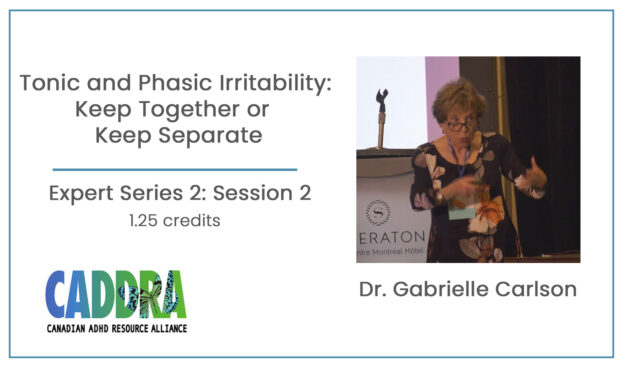Tonic and Phasic Irritability: Keep Together or Keep Separate?
By the end of this session, participants will be able to:
- Describe and delineate tonic versus phasic irritability.
- Discuss the difference between community and clinical samples.
- List measures for irritability and outbursts.
Irritability became a focus of interest on the heels of the bipolar controversy in children. That is, was there a special kind of extremely volatile and destructive but chronic form of irritability unique to childhood bipolar disorder? In addressing that question, two components to irritability were identified: an underlying mood (tonic irritability) and outward expression in the form of outbursts/tantrums (phasic irritability). Irritability is a proneness to anger. That has been measured by the frequency with which the manifestation occurs, how bad the reaction gets and how long it lasts. Irritability overlaps with anger, aggression, and outbursts and occurs in internalizing, externalizing, neurodevelopmental,psychotic and stress disorders, as well as disorders or conditions caused by medical or neurological conditions. In children and adolescents, severe and impairing irritability is estimated to range from 3.3% to 5.0% in epidemiologic samples . Heritability is estimated at 30-40%. Confirmatory Factor Analyses in a community sample of youth aged 7-18 years using parent-, child-, and clinician-rated measures have yielded separable factors for temper outburst (i.e., phasic irritability), aggression,and irritable mood between outbursts (i.e., tonic irritability), with high correlations between the tonic and phasic factors. Phasic irritability was found to be slightly more stable (54% for tonic and 63% for phasic irritability) and show a pattern more consistent with externalizing problems. Tonic irritability tends to exhibit a pattern of associations and outcomes that is more consonant with internalizing problems.
Dr. Gabrielle Carlson:
Gabrielle A. Carlson, M.D., has been professor of Psychiatry and Pediatrics since 1985. She founded and directed the Division of Child and Adolescent Psychiatry until 2013. She obtained her MD degree from Cornell University Medical College. She did her psychiatry training at Washington University in St. Louis, the NIMH and UCLA where she subsequently taught on the faculty. Dr. Carlson specializes in the subjects of childhood and adolescent depression, bipolar disorder and irritability. She has written over 300 papers and chapters on those subjects. Her research interests include the phenomenology, long term follow up and treatment of young people with bipolar disorder, and the relationship between behavior disorders, like ADHD, developmental disorders and mood disorders. Dr. Carlson has won numerous awards in the US including those from the American Psychiatric Association for research in child and adolescent psychiatry and another for prevention. She was awarded the American Psychopathological Association’s: Zubin Award, for playing a fundamental role in psychopathology research. She is especially proud of the Virginia Q Anthony Outstanding Woman Leader Award given by the American Academy of Child and Adolescent Psychiatry (AACAP). Dr. Carlson was Program Chair for four years for AACAP and is now is recent Past President of that organization. Her presidential initiative has been on emotion dysregulation in children.
CADDRA – Canadian ADHD Resource Alliance has been approved by the College of Family Physicians, the Royal College of Physicians and Surgeons of Canada and the Canadian Psychological Association to offer 1.25 continuing education credits for this session. CADDRA maintains responsibility for the program.
Participation in a discussion forum is required to claim full credits.
Course Content

